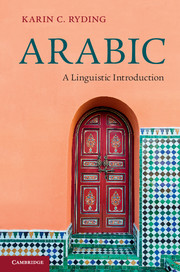Book contents
- Frontmatter
- Contents
- List of figures
- Preface
- Acknowledgments
- Abbreviations and symbols used in this book
- 1 Arabic linguistics: overview and history
- 2 Arabic phonology
- 3 Arabic phonotactics and morphophonology
- 4 Arabic syllable structure and stress
- 5 Introduction to Arabic morphology
- 6 Derivational morphology: the root/pattern system
- 7 Non-root/pattern morphology and the Arabic lexicon
- 8 Arabic inflectional morphology
- 9 Syntactic analysis and Arabic
- 10 Arabic syntax I: phrase structure
- 11 Arabic syntax II: clause structure
- Appendix A Fields of linguistics and Arabic
- Appendix B Arabic transcription/transliteration/romanization
- Appendix C Arabic nominal declensions
- Glossary of technical linguistic terms
- References
- Index
Appendix C - Arabic nominal declensions
Published online by Cambridge University Press: 05 June 2014
- Frontmatter
- Contents
- List of figures
- Preface
- Acknowledgments
- Abbreviations and symbols used in this book
- 1 Arabic linguistics: overview and history
- 2 Arabic phonology
- 3 Arabic phonotactics and morphophonology
- 4 Arabic syllable structure and stress
- 5 Introduction to Arabic morphology
- 6 Derivational morphology: the root/pattern system
- 7 Non-root/pattern morphology and the Arabic lexicon
- 8 Arabic inflectional morphology
- 9 Syntactic analysis and Arabic
- 10 Arabic syntax I: phrase structure
- 11 Arabic syntax II: clause structure
- Appendix A Fields of linguistics and Arabic
- Appendix B Arabic transcription/transliteration/romanization
- Appendix C Arabic nominal declensions
- Glossary of technical linguistic terms
- References
- Index
Summary
Modern standard Arabic nouns and adjectives fall into eight declensions. These categories of inflection are not usually treated separately as declensions in textbooks and grammars of Arabic, but I have found that this often leads to confusion for Arabic learners. I have therefore distinguished among all forms of nominal declension, including inflections for the suffix declensions of dual, sound feminine plural and sound masculine plural. Three-way inflection nominals (triptotes) are traditionally considered the base category because they exhibit three distinctive case-markings for nominative, genitive, and accusative. All other categories have fewer case distinctions: some two, some only one. Moreover, sometimes there is a distinction between definite and indefinite inflection, and sometimes not (for example, the declensions for the dual and for the sound masculine plural do not exhibit distinctions in definiteness).
Arabic nominal declensions:
Three-way inflection
(1) three-way inflection (‘triptote’)
Two-way inflection
(2) dual
(3) sound feminine plural
(4) sound masculine plural
(5) diptote
(6) defective
One-way inflection
(7) indeclinable (for case, but marking definiteness), and
(8) invariable
- Type
- Chapter
- Information
- ArabicA Linguistic Introduction, pp. 149 - 156Publisher: Cambridge University PressPrint publication year: 2014



